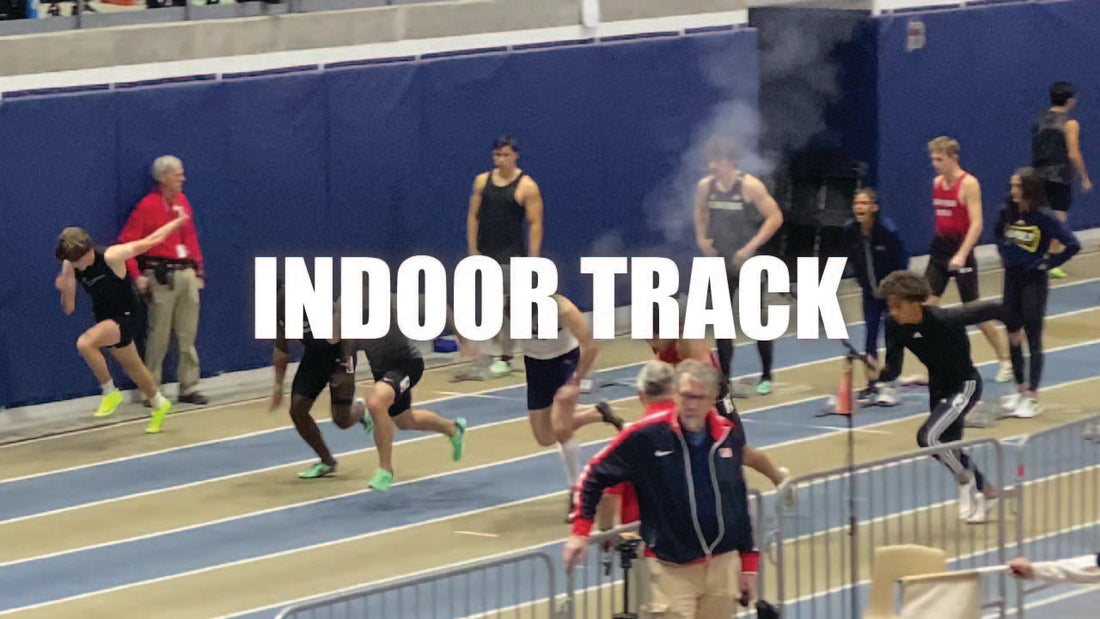Indoor Track & Field | Everything You Need To Know
This article will help you understand the few differences between indoor season and outdoor season, so you can be prepared for indoor meets and have an enjoyable experience.
What Is Indoor Track?
During the winter, many places in the world are not able to compete outdoors for track and field due to cold, snowy weather. Because of this, the first track season of every year is held indoors during the indoor track season.
Indoor tracks are usually found in states and countries that experience inclement weather in the winter, and are less common in places with nice weather year-round.

For example, there are very few indoor tracks in California because the weather is typically moderate throughout the year.
States that do not have access to indoor track facilities will often hold meets for the indoor season using standard indoor track events, but with the meet taking place on an outdoor track.
For schools who compete in conferences which have an indoor season, these "outdoor indoor" meets can be used for qualifying purposes.
Indoor track features running events, throwing events, jumping events, and combined. Some events, such as the 200m dash and 400m dash, use the same distance during both indoor and outdoor track.
Other events are only contested in either indoor or outdoor track, such as the 100m dash being contested outdoors and the 60m dash being ran indoors.
Indoor Track Vs Outdoor Track
While indoor track and outdoor track are both seasons within the sport of athletics, there are some important differences to have runners know when running indoors.
Indoor Tracks Are Smaller Than Outdoor Tracks
During indoor track, most competitions are held on 200m tracks with banked turns. Some indoor tracks, such as the Walk-Up Skydome at NAU, utilizes a flat 300 meter long track.
Because of this, an indoor running track typically has tighter turns, leading to generally slower times in running events like the 200 meter dash and 400 meter dash.
Indoor Track Is Not Contested At The Olympics
While outdoor track & field is included in the summer Olympics, indoor track is not contested at that level.
The Indoor Track & Field World Championships is the highest level track meet for indoor track, and it is held every 2 years.
Indoor Records Do Not Carry Over To Outdoor Track
When running indoors,
What Is The Difference Between Indoor And Outdoor Track Events
Some of the events that are contested during the indoor track season are different than they are during the outdoor track season.
Some outdoor events are not contested during indoor track, including:
- The 100 Meter Dash
- The 100 Meter Hurdles, 110 Meter Hurdles, 400 Meter Hurdles
- 3000m Steeplechase
- 10,000 Meter Run
- Racewalk events
- Discus
- Hammer
- Javelin
- Decathlon
Common indoor events that are not done in outdoor track include:
- The 50 Meter, 55 Meter, and 60 Meter Dash
- The 50m Hurdles, 55m Hurdles, and 60m Hurdles
- The 150 Meter Dash
- The 300 Meter Dash
- The 500 Meter Dash
- The 600 Meter Dash
- The Weight Throw
- The Pentathlon
- The 3000 Meter Run
Note that not all of these events will be done at every indoor track meet. Meet organizers will typically pick and choose which events to run, with shorter events happening earlier in the season such as the 150 meter dash which eventually is replaced by the 200 meter dash.
Many of the indoor track race event distances are contested both indoors and outdoors, including:
- 200 meter dash.
- 400 meter dash.
- Long Jump
- Triple Jump
- Shot Put
- 1500 Meter Run
- 1 Mile Run
Indoor Track - Frequently Asked Questions
How big is an indoor track, and what are the different sizes and shapes that are used?
Indoor tracks are typically 200 meters or 300 meters long, shaped in an oval, with either banked or flat turns.
What types of footwear are recommended for indoor track and field, and what are the rules regarding spike length?
When using an indoor track, athletes will need running shoes and track spikes or shoes specific to their event.
Spikes for track shoes length should not exceed one quarter of an inch, except for athletes competing in high jump.
What are some strategies for running on a banked indoor track, and how does it affect race times and performance?
When running on a banked track, you want to take advantage of the downhill portion by running relaxed and not overstriding.
Also, focus on staying on the inside of your lane so you can maintain your speed effectively and whip yourself out of the turn.
Banked tracks will typically slow your times down slightly, so keep that in mind when assessing your results. If you can run a lap in 50 seconds outdoors, you may run your laps in 50.5-51.0 on an indoor track.
When does indoor track season typically start and end, and what are some major indoor track and field events that take place during this time?
Indoor track typically begins in December or January, and finishes by the end of March.
Prominent indoor track and field meets include the New Balance Indoor Grand Prix and the USATF Indoor Track & Field Championships.
How do athletes prepare for indoor track and field competitions, and what are some training methods that are specific to indoor track events?
Training for indoor track & field is the same as for outdoor track, but the distances over which you train may be reduced.
You can check out my guides on 100 meter dash training, 200 meter dash training, and my page about how to sprint faster to get some tips on training for indoor track.
